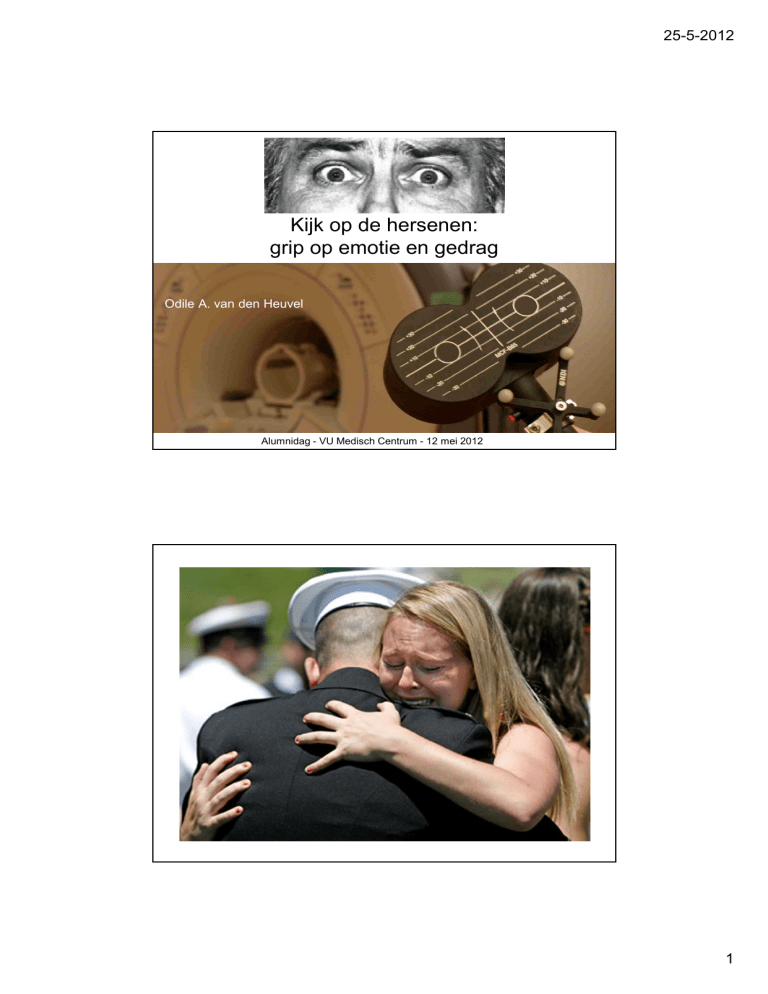
25-5-2012
Kijk op de hersenen:
grip op emotie en gedrag
Odile A. van den Heuvel
Alumnidag - VU Medisch Centrum - 12 mei 2012
1
25-5-2012
Gedachte:
‘ze zien elkaar na lange tijd weer terug, hij is
veilig teruggekomen van uitzending’
Gevoel:
blij, opgevlucht, ontspannen
Gedachte:
‘ze nemen voor altijd afscheid, hij zal sneuvelen
tijdens de uitzending’
Gevoel:
verdrietig, somber, angstig
2
25-5-2012
Mensen met een depressie (of een genetische aanleg
voor een depressie):
Verhoogde aandacht naar negatieve informatie
Beter geheugen voor negatieve dan voor positieve informatie
Verhoogde emotionele reactie op negatieve informatie
Aaron T. Beck
3
25-5-2012
emotie regulatie
(cognitieve therapie)
4
25-5-2012
Gedachte:
‘oppassen dat ik er niet in ga staan!’
Gevoel:
aversie, walging
Gedachte:
‘Er kunnen moleculen op mijn broek komen,
waardoor ik straks thuis de bank, de kat en mijn
kinderen kan besmetten.’
Gevoel:
angstig, gespannen
5
25-5-2012
Smetvrees
(obsessieve compulsieve stoornis - OCD)
angst level
Angst, voortkomend uit obsessies (dwanggedachten), wordt
bezworen met compulsies (dwanghandelingen).
obsessie
ontspanning
angst/stress
compulsie
tijd
Behandelen van angst
• Exposure in vivo (=gedragstherapie)
> extinctie van oude angstrespons
• Cognitieve therapie
> emotieregulatie door aanpassen van de gedachten
6
25-5-2012
ANGST
• Elementaire emotie
• Belangrijk voor de overleving
• Beschermt ons tegen gevaar
Joseph LeDoux
7
25-5-2012
Joseph LeDoux (The Amygdaloids)
QuickTime™ and a
H.264 decompressor
are needed to see this picture.
8
25-5-2012
amygdala
angstconditionering
extinctie
(exposure in vivo)
9
25-5-2012
extinctie
(exposure in vivo)
emotie regulatie
(cognitieve therapie)
Als angst regeert
10
25-5-2012
Het angstige brein
• Verminderd volume dmPFC
en verminderde top-down controle
vanuit PFC op amygdala
• Verhoogde activiteit limbische
systeem
model
Emotie
Ventraal
↑
ventrale fronto-striatale
& limbische circuits
Cognitie
Dorsaal ↓
dorsale fronto-striatale
circuit
11
25-5-2012
Hersenscanonderzoek
MRI/MRS
PET/SPECT
EEG/MEG
TMS
Transcraniële Magnetische Stimulatie (TMS)
12
25-5-2012
Transcraniële Magnetische Stimulatie (TMS)
Laag-frequent (1 Hz)
verminderde excitabiliteit
long-term depression
remming
‘knock-out’
Hoog-frequent (10 of 20 Hz)
verhoogde excitabiliteit
long-term potentiation
stimulatie
‘enhancement’
Transcraniële Magnetische Stimulatie (TMS)
• Als experimenteel instrument
• Als behandelalternatief
13
25-5-2012
model
Controles:
Laag-frequente rTMS vs. placebo
(= inhibitie)
Alternatief:
Diepe hersenstimulatie
(= remming van ventrale systeem)
OCD patiënten:
Hoog-frequente rTMS vs. placebo
(= stimulatie)
Emotie
Ventraal
Cognitie
↑
Dorsaal ↓
ventrale fronto-striatale
& limbische circuits
dorsale fronto-striatale
circuit
QuickTime™ and a
decompressor
are needed to see this picture.
14
25-5-2012
rTMS-fMRI ‘knockout’ model
a.s.a.p.
verum TMS vs. sham TMS
rTMS-fMRI ‘knockout’ model
15
25-5-2012
rTMS-fMRI ‘knockout’ model
Resting state
placebo TMS
Resting state
real TMS (1 Hz)
Inhibitie PFC > effect in dieper gelegen structuren
zoals de hippocampus
rTMS-fMRI ‘enhancement’ model
5 stimulus condities
Alg. angst
OCD-was
OCD-check
OCD-symmetrie
Neutraal
16
25-5-2012
rTMS-fMRI ‘enhancement’ model
2 instructie condities
•Kijk
Hoe onaangenaam
voelde u zich tijdens
het kijken naar de
foto?
Bekijk
•Reguleer
Niet
Max
3x
Hoe onaangenaam
voelde u zich tijdens
het kijken naar de
foto?
Reguleer
Niet
Max
Instructie
(3s)
Hoe goed lukte het u
de taak uit te
voeren?
Stimulus (10
s)
+
Niet
Max
Hoe goed lukte het u
de taak uit te
voeren?
+
3x
Affectieve Schaal
(5 s)
Niet
Max
Evaluatie (5
s)
Fixatie (4,73
s)
rTMS-fMRI ‘enhancement’ model
day 1
fMRI during
emotion regulation paradigm
version 1
SPM:
Single subject analysis
reappraise > attend
stimulation coordinates
day 2
20 min rTMS treatment
(1 Hz, 10 Hz or sham)
using neuronavigation
fMRI during
emotion regulation paradigm
version 2
a.s.a.p.
repeated measures analyses day 1 versus day 2, 1st level
2nd level group analysis
17
25-5-2012
rTMS-fMRI ‘enhancement’ model
in OCD patients:
emotion
cognition
10Hz rTMS vs. sham
(= stimulation)
normalized
increased
emotional response
inhibition dorsal system
Ventral
=↑
(ventral frontal-striatal circuit and amygdala)
decreased
improved
‘top-down control’
Dorsal
=
↓
(DLPFC, dorsal ACC)
decreased executive
functions
rTMS als adjuvant bij exposure in vivo?
18
25-5-2012
‘Body build the brain’
• Obsessieve Compulsieve Stoornis
• andere angststoornissen
• onderhoudsbehandeling na ECT?
• Cognitieve rehabilitatie?
– Parkinson
– Alzheimer
– Multiple Sclerosis
Dank
Dept. Anatomy & Neurosciences
‘section Neuropsychiatry’
Ysbrand van der Werf
Stella de Wit
Froukje de Vries
GGZ inGeest
Dick Veltman
Ton van Balkom
Patricia van Oppen
Jan Smit
Merijn Eikelenboom
Altrecht
Danielle Cath
Neuroscience Campus Amsterdam
Program ‘Brain Imaging’
Program ‘Anxiety & Depression’
Institute of Pasychiatry, King’s College London, London
David Mataix-Cols
University of Toronto
Tomas Paus
VENI NWO ZonMW:
Young Investigator’s Award:
19












